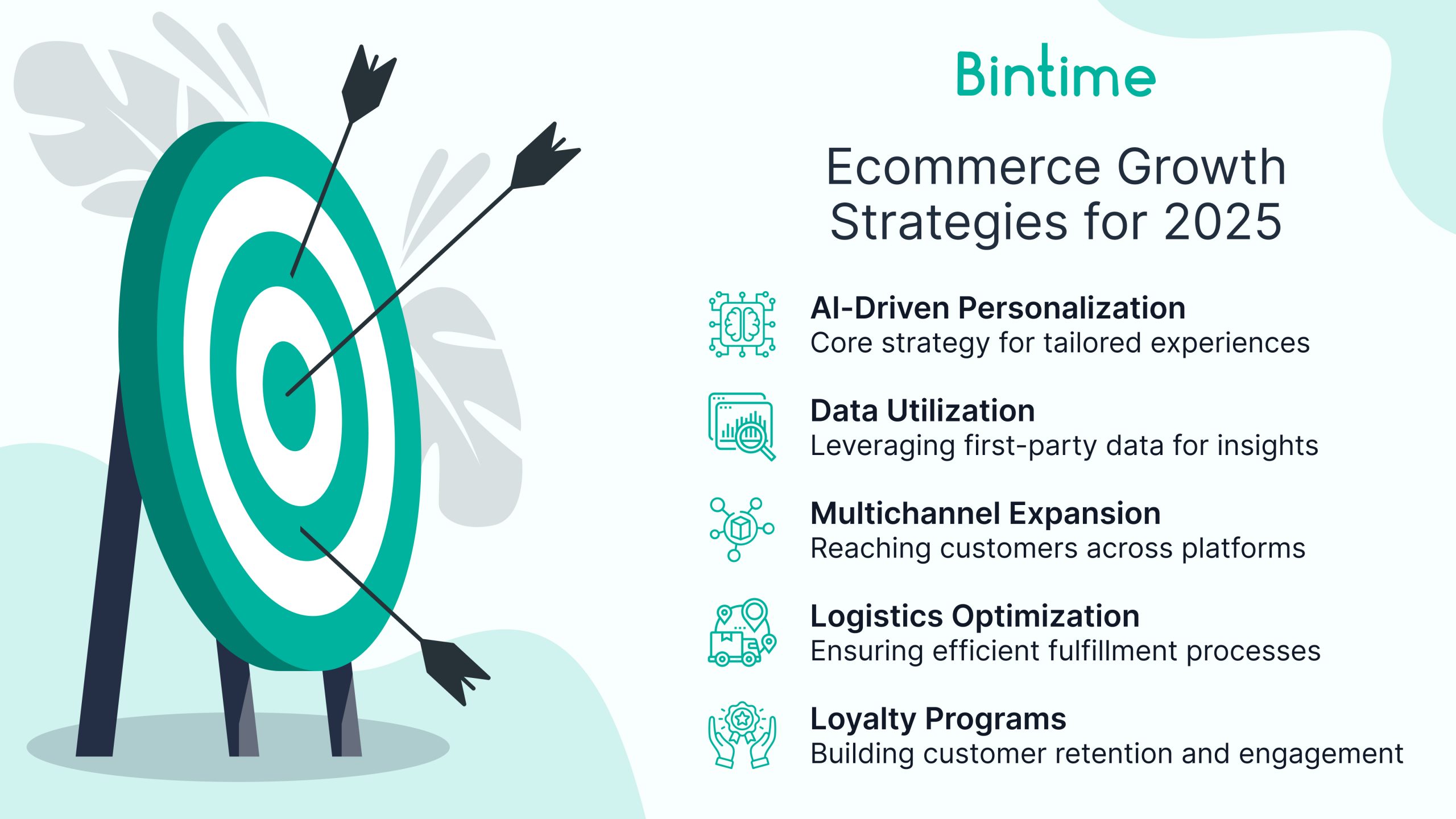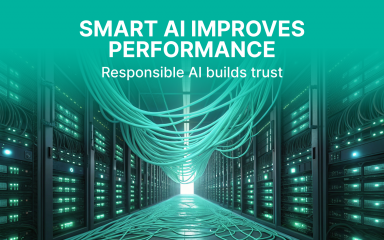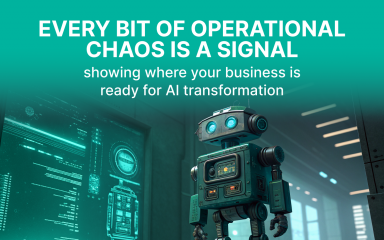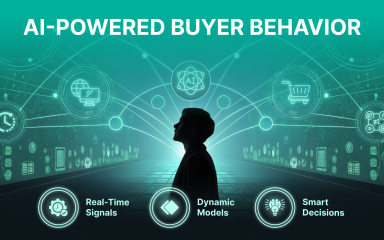Ecommerce Growth Strategies for 2025: Trends You Can’t Ignore
2025 is not the year to play it safe.
Online shoppers expect more than ever: smarter search results, faster shipping, and a personalized online shopping experience across all marketing channels. With Google’s AI Mode transforming how people discover and shop for products using search engines and social media platforms, your ecommerce growth strategy must speak to both human customers and AI agents.
For ecommerce businesses — from emerging brands to major retailers — this shift is more than technical. It’s strategic. Business success now depends on the optimization of customer data, tracking consumer behavior, and delivering value through every step of the customer journey, as well as a strong ecommerce tactics.
This article unpacks what ecommerce companies need to know to stay relevant, attract new customers, and build customer relationships that drive sales, increase brand loyalty, and help build customer loyalty in an increasingly competitive ecommerce market.
Why Your Ecommerce Growth Strategy Needs to Evolve in 2025
The traditional ecommerce strategy plan is outdated. Online shopping is now shaped by real-time personalization, intelligent automation, and mobile-first design. To succeed, ecommerce retailers must rethink their approach fast in a competitive ecommerce market.
Key Changes in 2025:
- Instant, tailored digital experiences
- AI-powered search now influences product discovery more than traditional search engine optimization
- Cross-platform consistency and engagement
- Consumers interact across devices, social platforms, and ecommerce platforms seamlessly
- Cookie deprecation and privacy laws require a new reliance on first-party client data
If retail executives’ e-commerce strategy isn’t evolving to address these ecommerce trends, you’re missing your target audience and losing organic traffic to smarter competitors. And if you’re serious about how to grow your ecommerce business, AI needs to be embedded in every layer of your operations.

7 Proven Ecommerce Growth Strategies for 2025 (and Why They Work)
1. How Hyper-Personalized Experiences Boost Ecommerce Sales in 2025
Generic product recommendations no longer suffice. Online shoppers expect AI-driven personalization at every touchpoint, built on user demographics, browsing patterns, and real-time user behavior.
Quick tip: Implement AI and machine learning to analyze data, personalize your homepage, product descriptions, and email marketing based on real-time behavior.
2. Using First-Party Data and Predictive Analytics for Ecommerce Growth
With third-party tracking fading, ecommerce companies must build strategies powered by their data.
Quick tip: Deploy a Customer Data Platform (CDP) to integrate data across other marketing channels, and use predictive models to drive highly targeted marketing. Collect customer comments, shopping history, and behavioral signals to create data driven insights that shape campaigns and loyalty programs.
3. Increase Sales with Conversational Commerce and AI Chatbots
Customer inquiries shouldn’t feel like a support ticket. Intelligent chatbots now act as proactive sales assistants.
Quick tip: Program chatbots to proactively recommend products or instantly handle FAQs based on customer history, reviews, and preferences. Integrate chatbots into your online store to respond to questions and upsell based on customer preferences.
4. Multichannel and Cross-Border Expansion: Essential Ecommerce Strategies
If you only focus on your growing ecommerce platform, you’re missing shoppers on social media, marketplaces, and influencer marketing feeds.
Quick tip: Use a Product Information Management (PIM) solution to sync data, descriptions, and product listings across social media platforms, Google Shopping, Amazon.
5. Boost Conversions with AI-Powered Visual Search and Dynamic Merchandising
More than half of online traffic now comes from mobile users who expect visual-first discovery and accurate results.
Quick tip: Enable visual search and optimize for mobile. Use buyer data to dynamically display the most relevant products, reviews, and user generated content.
6. Smarter Fulfillment as a Core Ecommerce Business Strategy
Accurate forecasting and logistics optimization builds trust. Fast, predictable delivery is essential in strategies for ecommerce success.
Quick tip: Use AI in supply chain for demand forecasting and dynamic logistics routing, which is particularly beneficial during peak shopping periods and for smoother shopping online experience.
7. Loyalty 2.0: Subscription Models and Customer-Centric Rewards
Traditional loyalty programs are outdated. 2025 calls for flexibility and deeper customer engagement.
Quick tip: Allow subscription services flexibility (skips, swaps, bundles), offer rewards to existing customers, and include user behavior in unlocking perks. This gives you a competitive edge.
How AI is Revolutionizing Ecommerce Strategies in 2025
AI isn’t just an add-on — it’s foundational. Smart ecommerce strategies now use AI for everything from personalization to fraud prevention.
Key areas AI impacts most:
- Marketing strategy: Predict buying intent, personalize email marketing, and automate digital marketing and marketing campaigns
- Product discovery: Use Google Analytics and heatmap tools to improve navigation
- Conversion boosts: Combine social proof, dynamic pricing, and video content to improve performance
A data driven approach means better ROI, stronger customer relationships, and smarter, more scalable decisions.
 Real-World Examples: Brands Winning with These Strategies
Real-World Examples: Brands Winning with These Strategies
Decathlon: Global Scale Meets Intelligent Automation
In 2025, Decathlon partnered with Cisco Meraki to overhaul its global network online store infrastructure, and the results are shaping the future of smart online retailers. Operating in over 80 countries with 2,000+ sites, Decathlon needed more than just Wi-Fi. It needed a scalable, automated, secure digital backbone solution.
By deploying Cisco Meraki’s full stack (MX, MS, MR), the brand achieved:
- 2.5 million API calls/month powering real-time automation across stores, warehouses, and HQs
- Seamless network expansion ata global scale, thanks to Meraki’s cloud-based architecture
- High-visibility security monitoring across all sites, enabling decentralized compliance
Takeaway: By aligning IT innovation with business growth, Decathlon turned its network into a strategic asset, enabling faster launches, better inventory performance, and a smoother customer experience worldwide.
Glossier: Scaling Intimacy with AI-Powered Personalization
Glossier, the direct-to-consumer beauty brand, has built a USD 1.8 billion empire by intertwining community engagement with cutting-edge AI personalization.
In 2024, Glossier integrated Yuma’s AI suite — encompassing Sales AI, Chat AI, and Social AI — into its operations. This move enabled real-time, personalized customer interactions across various touchpoints, from product discovery to post-purchase support. The result? Enhanced customer experience and increased revenue per visitor.
Moreover, Glossier’s behavioral targeting system analyzes social media engagement, purchase patterns, and skin type preferences to craft highly targeted email marketing. Their recommendation engines suggest products based on individual skin concerns, previous purchases, and seasonal beauty trends, achieving email open rates 45% higher than industry averages.
Takeaway: Glossier’s fusion of community-driven content and AI personalization sets a new standard in beauty e-commerce, demonstrating how technology can enhance, rather than replace, authentic customer relationships. The best ecommerce strategies are data-driven but emotionally intelligent.
ASOS: Leveraging AI for Operational Excellence
ASOS, the UK-based online fashion retailer, has embarked on a transformative journey by integrating AI to optimize its operations and customer experience.
In 2024, ASOS announced a three-year collaboration with Microsoft to harness AI capabilities across its business marketing strategy. This partnership focuses on process automation, data-driven decision-making, and enhancing customer interactions. Using Microsoft’s AI tools, including Power Automate and Copilot, ASOS aims to streamline operations and free up employee time for more strategic tasks.
Furthermore, ASOS employs AI-powered recommendation engines to provide personalized product suggestions, enhancing the shopping experience and increasing conversion rates. These systems analyze customer browsing behavior and purchase history to deliver tailored recommendations in real-time, giving them a competitive advantage.
Takeaway: ASOS’s strategic integration of AI across its operations exemplifies how technology can drive efficiency, reduce costs, and enhance the customer experience in the competitive world of online fashion retail. Automation unlocks global scale and local agility for many brands exploring international ecommerce strategy. Cloud-native software solutions are key to resilience.
How to Prioritize and Implement These Strategies
Trying to do everything at once? Guaranteed burnout. Instead, use this phased approach:
Step-by-step:
- Audit your existing ecommerce strategy
- Identify gaps in client engagement and mobile performance
- Use google analytics, customer feedback, and user demographics to refine segments
- Choose software that integrates across all marketing channels
- Empower your team to create content, especially video content and user generated content tailored to your target audience
This is how to grow ecommerce business without chaos or burnout. The best ecommerce strategy is one your entire team understands and can act on.
FAQ: Ecommerce Growth in 2025
What is the best ecommerce growth strategy in 2025?
The most effective strategy combines AI-powered personalization with robust first-party data utilization of customer data to personalize the online shopping experience across your store, emails, and social media. With the phasing out of third-party cookies, brands focus on collecting and leveraging data directly from other customers to deliver personalized experiences. This approach enhances buyer engagement and ensures compliance with privacy regulations.
How do I improve shopping online experiences?
Focus on fast sites, clear navigation, AI-powered inventory management, and real customer reviews. Modern consumers want flexibility. Loyalty is now about relevance, user generated content, and consumer behavior rewards. Rely on LTV, conversion rate, subscription retention, and insights from Google Analytics and customer feedback.
Do small businesses need AI to stay competitive?
Absolutely. AI tools have become more accessible and affordable, offering features like automated customer support, personalized marketing. Platforms such as Shopify’s “Shopify Magic” provide AI capabilities that were once exclusive to large enterprises, enabling small businesses to compete effectively in the digital marketplace.
How can ecommerce brands use AI for fulfillment?
AI enhances fulfillment by optimizing product management, predicting demand, and streamlining logistics. For instance, Amazon employs AI-driven robots and predictive analytics to improve warehouse efficiency and delivery speed, resulting in significant cost savings and improved customer satisfaction.
Is omnichannel still important?
More than ever. Consumers expect a seamless shopping experience across various online, mobile, and in-store channels. Retailers implementing omnichannel strategies see higher customer retention and engagement rates, as they meet customers wherever they shop.
Is influencer marketing still relevant?
Absolutely. It’s evolving with short-form video content, micro-creators, and cross-posting across media platforms. And brings new customers to drive sales.
What KPIs should we track for ecommerce growth?
Key performance indicators to monitor include:
- Customer Lifetime Value (CLV): Measures the total revenue a customer is expected to generate over their relationship with your brand.
- Repeat Purchase Rate (RPR): Indicates customer satisfaction.
- Cart Abandonment Rate: Helps identify friction points in the checkout process.
- Fulfillment Speed: Reflects the efficiency of your order processing and delivery systems.
- Customer Acquisition Cost (CAC): Assesses the cost-effectiveness of your marketing efforts.
Tracking these KPIs provides insights into customer behavior and operational efficiency, guiding strategic decisions for growth.
 Real-World Examples:
Real-World Examples: 










